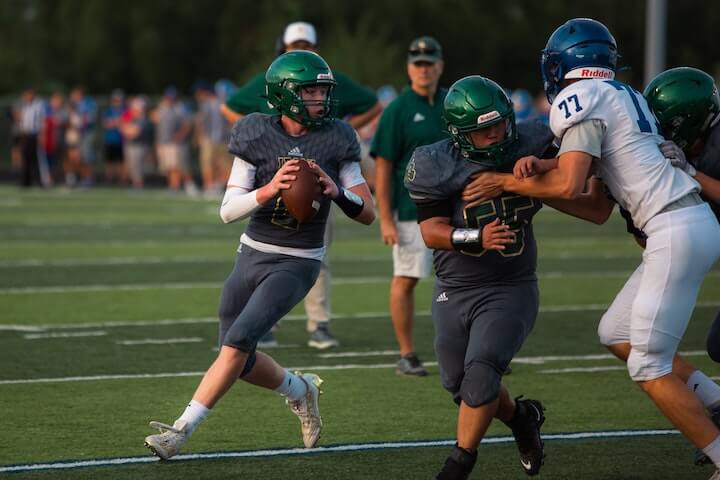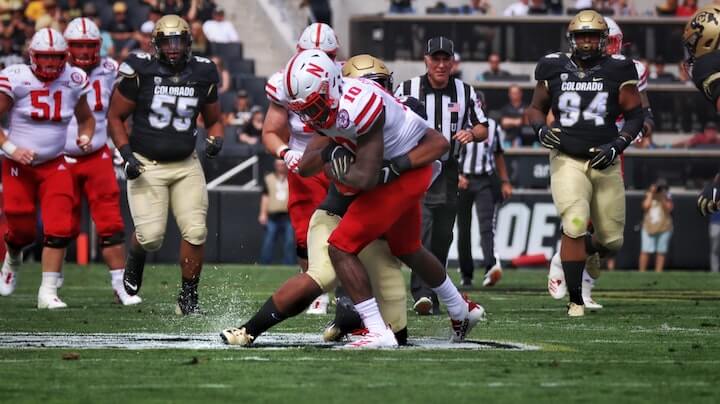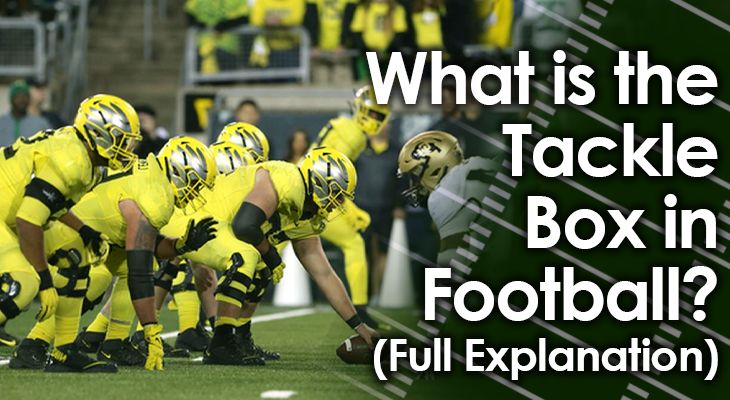The "tackle box" is a term you'll hear referenced many times throughout a game.
In most cases, it comes up in conversation when the offense is attempting a pass.
While it isn't a set area outlined on the field, it does have a very distinct definition.
Also referred to as 'the pocket', it refers to the area on the field between the two offensive tackles, but extends slightly outside of that range.
The tackle box area determines some rules in the game, including what the quarterback can and cannot do based on where he is on the field.
To that end, it's very important that all coaches understand what a tackle box is, and that all quarterbacks are very familiar with it as well.
Let's take a deeper dive:
What is the Tackle Box in Football?
The tackle box in football is an imaginary area that signifies where the "pocket" is on passing plays.
While you won't find it outlined anywhere on a football field, it does have a set definition as well as application in terms of how some rules are applied.
The width of the tackle box is determined by where both offensive tackles line up to begin a play.
The top left corner meets at the line of scrimmage and two yards to the left of the left tackle's outside shoulder, while the top right corner meets at the line of scrimmage and two yards to the right of the right tackle's outside shoulder.
The top of the box is the line of scrimmage itself, meeting at the two top corners.
The outside lines of the box extend from the two top corners in a straight line all the way back through the offense's own end zone.
The back line of the box is a straight line across at the back line of the end zone, connecting the two sides of the tackle box.
Keep in mind that the tackle box depends on where the offensive tackles line up, regardless of where the other players on the field line up.
In other words, the tackle box doesn’t extend out to the sideline more if there is a tight end lined up next to one (or both) of the offensive tackles.

Rules for Quarterbacks
When the quarterback is inside the tackle box, he has to try to throw a ball in the general direction of one of his receivers.
This doesn't mean the quarterback can't throw the ball away if he's in trouble and can't find an open receiver. Quarterbacks will do this from time to time.
What it means is that when the quarterback "throws the ball away," he must do so in the general direction of one of his receivers.
He can sail the ball over a receiver's head and out of bounds, for instance, but he can't simply throw it out of bounds if there is no receiver in that vicinity.
If a referee determines that the quarterback DOESN'T try to throw the ball in the general direction of a receiver while he's inside the pocket, he might get called for an intentional grounding penalty.
This would result in a loss of yardage back to the spot where the quarterback threw the ball, plus a loss of down.
It's a killer penalty for the offense, so quarterbacks need to avoid it at all costs.
If the quarterback scrambles outside of the pocket, he doesn't have to attempt to throw the ball to a receiver.
He can throw the ball away without it going in the direction of a receiver and avoid a penalty, as long as the ball crosses the line of scrimmage.
Rules for Offensive Linemen
The tackle box also determines some rules for offensive linemen.
Any lineman who blocks within the area is not allowed to grab any single part of a defensive player outside of their shoulder pads.
While they can extend their arms and hands to block, they can't grab a defender's uniform while they are doing that.
If an offensive lineman were to do that, he would likely get called for an offensive holding penalty, which would result in a 10-yard penalty and a repeat of the down.
Once offensive linemen are outside the box, they still aren't allowed to grab onto defenders... but they may block outside of a defender's shoulder pads.

Rules for Defenders
There are rules for how defenders are able to hit quarterbacks in the tackle box.
If a defender is blitzing a quarterback who is within the tackle box, he cannot lead with his helmet to make a hit or tackle the quarterback below his knees.
The only way a defender can make contact with the QB within the tackle box is to hit him below his shoulders and above his knees, while also wrapping him up.
When the quarterback is outside of the tackle box, these rules DO NOT apply.
In essence, when a quarterback exits the tackle box, he is then considered a runner -- even if he is still behind the line of scrimmage.
This opens him up to getting tackled below the knees, just as running backs, tight ends, and wide receivers can be.
Conclusion
The tackle box in football is an imaginary part of the field determined by where offensive tackles line up, regardless of where other players start.
It has real effects on how some rules apply -- which quarterbacks, linemen, and defenders all must follow on passing plays.
The penalties for breaking any of these rules are quite serious...
Which is why coaches need to educate all their players on what the tackle box is and how that determines what they can and can't do.

